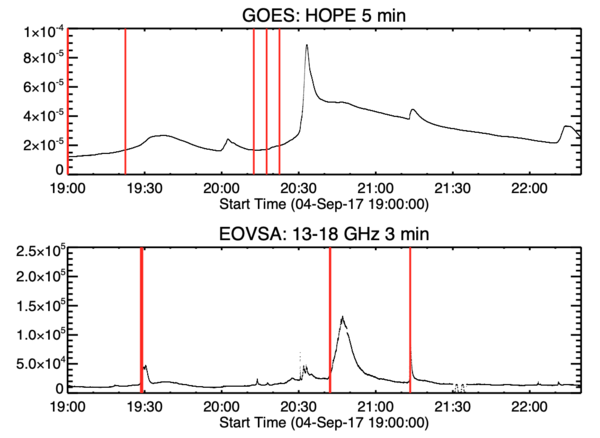Search for a Flare Anticipation Index (FAI)
From RHESSI Wiki
| Nugget | |
|---|---|
| Number: | 460 |
| 1st Author: | Hugh HUDSON |
| 2nd Author: | Jim McTIERNAN |
| Published: | November 13, 2023 |
| Next Nugget: | TBD |
| Previous Nugget: | Bouncing motions of fast electrons using Nobeyama Radioheliograph |
| List all | |
Contents |
Introduction
Flares often have precursor signatures that anticipate what is to happen. Can we codify this as an "Anticipation Index" (AI), or even learn how to interpret the signals to predict the characteristics (total energy, time scale, or other)? Flare precursors are often described, frequently as anecdotal issues in papers about individual flares, but the most useful Flare Anticipation Index would be one that precedes the flare by a few minutes, is robust, and is infallible. Among precursor phenomena we could list
Filament rise Filament activation Preflare EUV dimming Preflare emission-line broadening Microwave precursor (Ref. [1]) Soft X-ray hot onset (HOPE; Ref. [2])
among others. Of those listed the first three apply mainly to eruptive flares, but the latter three may be more general.
We want to gain systematic knowledge of flare precursors just for their physical significance, but there is also a practical application for any FAI that can give few-minute advance notice: to enable initiation of an observing campaign, such as a rocket launches.
Microwave precursors
The important Ref. [1] described the pioneering observations from an early development of the Owens Valley Radio Observatory, but it seems to have excited little attention at the time. These observations showed a gradual increase at low flux levels (below one SFU, a very low level for the Sun). At present we do not understand the mechanism of this phenomenon. In this Nugget we describe an initial FAI application of EOVSA (Owens Valley): broad-band sums of visibilities over three spectral ranges over 1-18 GHz.
Hot Onset Precursor Events
Ref. [2] pointed out that virtually all solar flares, as observed in soft X-rays, actually have a "hot onset" precursor, during which isothermal fits to the two-channel GOES data show increasing emission measure at roughly constant temperature, typically about 10 MK. This is the HOPE ("Hot Onset Precursor Event"), and it is also not understood systematically at present.
Successful flare anticipation
To test these microwave and soft X-ray signatures, we have initially tried one active day, 4-September-2017, which had 13 GOES events including six in the Owens Valley daytime. Very simple independent FAI algorithms used running-difference fluxes for the microwaves, and an index based on both emission-measure increase and temperature. Figure 1 show that between these two indices, we had four "true positives," no "false positives," and two false negatives. Pretty good, but not perfect statistical results.
Conclusion
To quantify the microwave and soft X-ray signatures of flare precursor activity, we have devised "flare anticipation indices" for soft X-ray and microwave data with some success. This clearly establishes the possibility of a joint FAI development, using both of these but also others of the signatures listed above, to establish a robust (and infallible?) few-minute FAI capability. Now some hard work is necessary to refine and improve on these findings. Also, it should go without saying, we need to figure out how these various precursors relate physically to their flares... it is certainly not simply "preheating," as we perhaps used to think.
[2] "Hot X-ray onsets of solar flares"
| RHESSI Nugget Date | 13 November 2023 + |
| RHESSI Nugget First Author | Hugh HUDSON + |
| RHESSI Nugget Index | 460 + |
| RHESSI Nugget Second Author | Jim McTIERNAN + |
